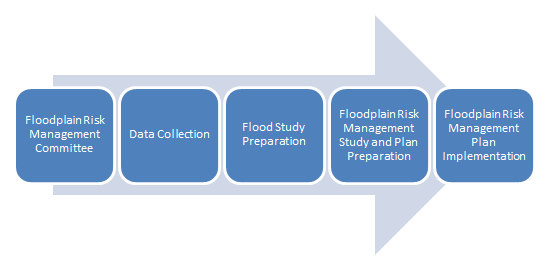Floodplain Management
What is a flood?
A flood occurs when there is water where it shouldn't be.
Flooding occurs in two ways. The first is when rain falls and the water runs downhill, eventually reaching a drainage pit, creek or river. This is known as overland flow.
The second is when a river or creek has more water running through it than normal and begins to increase in depth, covering land that it didn't before. This is known as mainstream flooding.
Flooding in Campbelltown Local Government Area
Compared to areas you may have seen on the news in recent years, flooding in Campbelltown is not very severe and stormwater drainage systems have been well planned, built and maintained.
Flooding which does occur is generally of very short duration, but also with short warning times. Most of the Campbelltown Local Government Area (LGA), if flooding does occur, will experience overland flooding. Very few properties on both the George's and Nepean Rivers experience mainstream flooding.
Managing flooding in Campbelltown
To manage flooding, it is important to first understand how flooding occurs, what areas are most at risk and then ways to manage the flooding can be developed. The NSW Government Floodplain Development Manual outlines the following method for achieving this. By following this process, Council can also apply for financial assistance from the State Government in the development of flood studies, floodplain risk management studies and plans and construction of flood mitigation works.

Flood studies and Floodplain Risk Management Studies and Plans
A Flood Study takes all the relevant information in the area to model how a flood will occur. This information includes topography, stormwater drainage infrastructure locations of buildings and anything else which may impact how water moves through a catchment. A different range of flood events are then modelled and maps showing the depth of the flooding, how fast the flood waters move and the flood hazard are produced.
The information from the Flood Study is then used to complete the Floodplain Risk Management Study and Plan. The Floodplain Risk Management Study uses this information to identify areas which will be impacted by flooding and looks at ways to minimise these impacts. Generally, the Study will identify areas where there may be flood waters moving through a house or which will be dangerous for the community.
Campbelltown Flood Studies and Floodplain Risk Management Studies and Plans
Council has completed a flood study for the Bow Bowing Bunbury Curran Creek Catchment and has finalised the Bow Bowing Bunbury Curran Creek Catchment Strategic Floodplain Risk Management Study and Plan.
Volume 1 - Bow Bowing Bunbury Curran Creek Strategic Floodplain Risk Management Study and Plan(PDF, 114MB)
Volume 2 - Bow Bowing Bunbury Curran Creek Strategic Floodplain Risk Management Study and Plan(PDF, 55MB)
Work is currently underway for the preparation of a flood study for a number of catchments to the south of the LGA (mainly around the suburbs of Airds, St Helens Park and Rosemeadow). This is expected to be completed towards the end of 2022.
Floodplain Risk Management Committee
The Bow Bowing Bunbury Curran Floodplain Risk Management Committee meets as necessary to discuss and review Flood Studies, Floodplain Risk Management Plans and other flooding issues.
More information
If you need information on flooding for a specific property, please complete the Stormwater Advice Request Form(PDF, 77KB).
For more information regarding flood studies, floodplain risk, management studies and plans, the floodplain risk management committee or flooding in general, please contact Council on 02 4645 4000 or by email at floodstudy@campbelltown.nsw.gov.au.